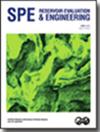低矿化度水驱细运移的理论与实验研究:盐水成分对颗粒间力的影响
IF 1.5
4区 工程技术
Q3 ENERGY & FUELS
引用次数: 3
摘要
大多数砂岩储层含有粘土颗粒。当粘土暴露于低盐度水中时,由于多离子交换和双电层(EDL)膨胀,粘土发生了细小的剥离和迁移。低矿化度水的精细运移提高了采收率,同时也破坏了注采井。研究了粘土颗粒重量百分比(wt%)、离子强度、总溶解固形物和低矿化度水注入速率对细运移的影响。测定了高岭石-高岭石体系和高岭石-石英体系在不同介质中的颗粒间力。制作了10个石英砂岩包,分别含有2%、5%和10%的高岭石,以模拟富粘土砂岩储层。随后,在不同场景的沙包中注入不同的盐水(10和50 mM的NaCl、CaCl2、MgCl2和Na2SO4盐溶液以及海水及其稀释后的样品)。在10mm NaCl、Na2SO4和50mm NaCl溶液中,两种体系的粒子间力均为斥力。因此,即使注入这些样品的低流速(0.1 cm3/min),也可以观察到总精细运移,导致高富粘土砂岩的渗透率大幅降低。而对于低含泥沙层,在进行细运移后,渗透率值开始上升一段时间。在含有50 mM MgCl2和CaCl2的盐水、海水及其5倍稀释的样品存在下,粒子间的作用力相互吸引,在任何条件下都发生了精细迁移。然而,在其他低盐度水样品中,高岭土-高岭土体系中的粒子间力为排斥力,而高岭土-石英体系中的粒子间力为吸引力。因此,在注水过程中会出现局部细运移现象。因此,在低粘土沙层中,细粒只有在高速注入时才会迁移。然而,对于含有10 wt%粘土颗粒的沙包,即使通过低流量注入,也存在明显的精细运移。一般来说,在驱油水中,细迁移强度与二价阳离子浓度之间存在一种权衡关系。去除这些阳离子或在10 mM浓度下使用它们可能会导致全细迁移,这对低含泥介质有利,但对富泥介质破坏强烈。高浓度的这些阳离子阻止了颗粒的移动,从而消除了低盐度驱油的优势。然而,使用中等浓度会导致部分精细运移,在这种情况下,其强度取决于粘土浓度和驱油速率。本文章由计算机程序翻译,如有差异,请以英文原文为准。
Theoretical and Experimental Study of Fine Migration During Low-Salinity Water Flooding: Effect of Brine Composition on Interparticle Forces
The majority of sandstone reservoirs contain clay particles. When clay is exposed to low-salinity water, fine detachment and migration occur due to multi-ion exchange and electrical double layer (EDL) expansion. Fine migration due to low-salinity water enhances oil recovery while damaging injection and production wells.
This research investigates the effect of clay particles' weight percentage (wt%), ionic strength, total dissolved solids, and the injection rate of the low-salinity water on fine migration. The interparticle forces of kaolinite-kaolinite and kaolinite-quartz systems in various mediums were determined. Ten quartz sandpacks containing 2, 5, and 10 wt% of kaolinite were made to simulate clay-rich sandstone reservoirs. Afterward, different brines (10 and 50 mM solutions of NaCl, CaCl2, MgCl2, and Na2SO4 salts as well as seawater and its diluted samples) were injected into these sandpacks with different scenarios. It was observed that the interparticle forces for both systems in the presence of 10 mM solutions of NaCl, Na2SO4, and also 50 mM NaCl are repulsive.
Therefore, even by injecting the low flow rate of these samples (0.1 cm3/min), the total fine migration was observed leading to intense permeability reduction in high clay-rich sandstones. However, in the case of low clay-containing sandpacks, the magnitude of permeability starts to rise a while after getting imposed to fine migration. In the presence of brines containing 50 mM MgCl2 and CaCl2, seawater, and its five-times diluted sample, the interparticle forces were an attraction, and fine migration occurred under no condition. However, using other samples of low-salinity water, the interparticle forces in the kaolin-kaolin system were repulsive and attractive in the kaolin-quartz system. Therefore, the phenomenon of partial fine migration occurs while flooding. So, in low-clay sandpacks, fines migrated only in high rate injection. However, the fine migration was evident for sandpacks containing 10 wt% of clay particles even by low flow rate injection. In general, there is a trade-off between the intensity of fine migration and divalent cations concentration in flooding water. Eliminating these cations or using them at 10 mM concentration may result in total fine migration, which is beneficial for low clay-containing media but damages clay-rich ones strongly. A high concentration of these cations prevents fines from movement, eradicating low-salinity flooding advantages. However, using medium concentrations results in partial fine migration, and the intensity, in this case, depends on clay concentration and flooding rate.
求助全文
通过发布文献求助,成功后即可免费获取论文全文。
去求助
来源期刊
CiteScore
5.30
自引率
0.00%
发文量
68
审稿时长
12 months
期刊介绍:
Covers the application of a wide range of topics, including reservoir characterization, geology and geophysics, core analysis, well logging, well testing, reservoir management, enhanced oil recovery, fluid mechanics, performance prediction, reservoir simulation, digital energy, uncertainty/risk assessment, information management, resource and reserve evaluation, portfolio/asset management, project valuation, and petroleum economics.

 求助内容:
求助内容: 应助结果提醒方式:
应助结果提醒方式:


